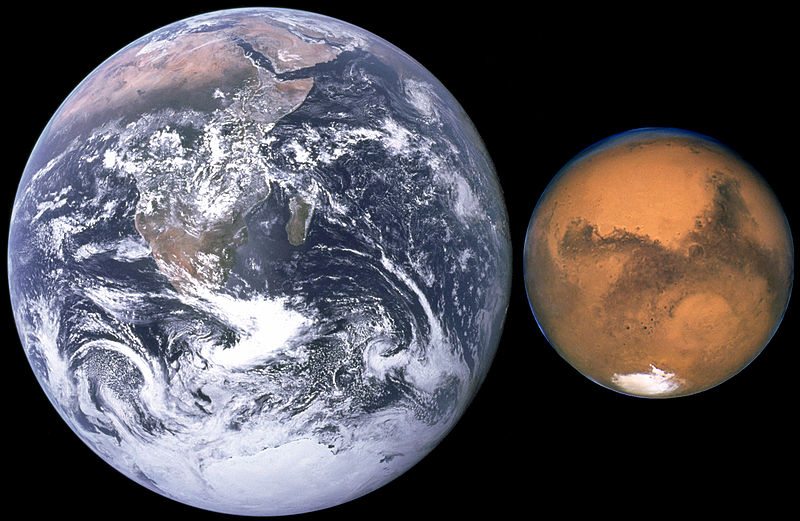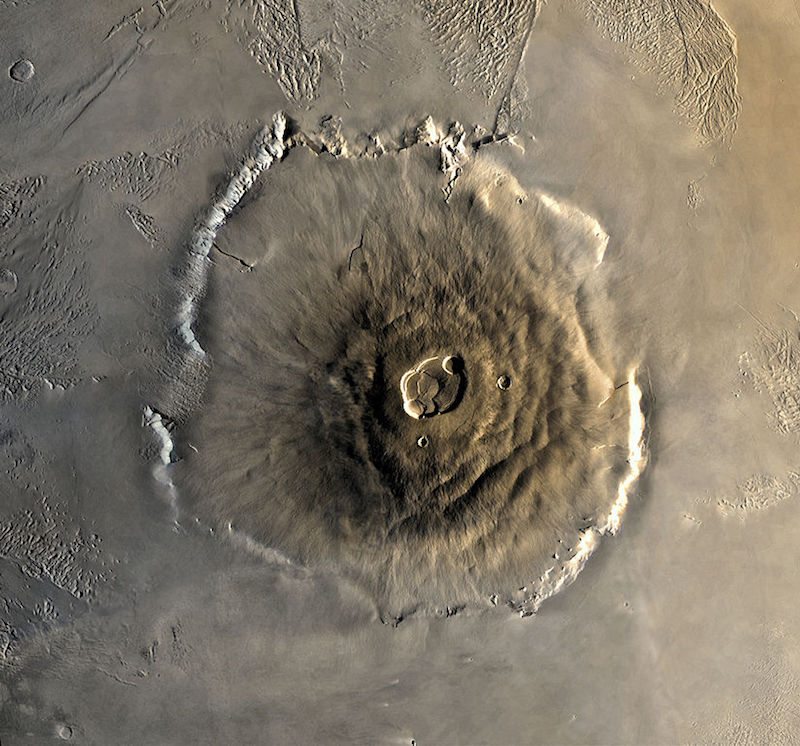Mars
Episode #4 of the course Introduction to the Solar System
Mars takes its name from the Roman god of war and is sometimes referred to as the “Red Planet,” given the reddish appearance caused by the iron oxide present on its surface.
This terrestrial planet is the fourth planet from the Sun and the second smallest planet in the solar system (after Mercury). Mars is never less than 34 million miles (54.7 million km) away from Earth and is only about half the size (measuring approximately 4,220 miles (6,779 km) in diameter compared to Earth’s 7,926 mile (12,755 km) diameter).

Size comparison of Mars and Earth

Animation of Mars’ and Earth’s revolution around the Sun
Mars has two relatively small natural moons, Phobos (about 14 miles (22 km) in diameter) and Deimos (about 7.5 miles (12 km) in diameter), which orbit close to the planet. Both satellites were discovered in 1877 by Asaph Hall; they are named after the characters Phobos (panic/fear) and Deimos (terror/dread), who, in Greek mythology, accompanied their father Ares, god of war, into battle. Mars was the Roman counterpart of Ares.
Many scientists agree that if human beings ever inhabit another planet in our solar system, Mars is the most likely candidate. Still, the Martian environment is a harsh, desolate place. The environment is cold (dipping down to -100 degrees Fahrenheit (-73 degrees Celsius) every night) and dry. The surface is covered in sand dunes and red hills full of iron oxide—which is basically rust—that has turned into dust particles. This red atmosphere typically kicks up huge, colorful dust storms that can literally darken the skies for months at a time. Take into account that the atmosphere contains no oxygen and is made up almost entirely of carbon dioxide and you’ll understand what makes Martian terrain brutal and inhospitable.

The tenuous atmosphere of Mars visible on the horizon
Today, Earth and Mars are two very different worlds, but scientists theorize that Mars was once rather similar to Earth. They believe it was once warm enough for large amounts of liquid water to flow across its surface, even though no liquid water remains on the planet today. Satellite images of Mars suggest that water once sculpted certain features of its terrain. However, evidence suggests that tons of ice might lie just below the Martian polar caps. These polar caps are visible from simple telescopes on Earth and are quite distinctive to spacecraft approaching the planet. Scientists believe that these polar caps could be the residue of once vast oceans, and recent studies suggest that liquid water flows intermittently on present-day Mars.
While these oceans are gone, another important landmark on the Martian terrain is Olympus Mons (Latin for Mount Olympus), a dormant volcano that stands 15 miles (24 km) above the Martian surface and is the tallest known peak in the solar system.

A composite Viking orbiter image of Olympus Mons on Mars
Early observers of the Red Planet were confused by its appearing to move backward across the night sky. However, in 1514, the study of Mars’ movement led Polish astronomer Nicolaus Copernicus to theorize that the planets were indeed orbiting around the Sun, not the Earth. Astronomers pointed the first telescopes toward Mars in 1610; then, in the late 1800s, director of the Milan Observatory Giovanni Schiaparelli began sketching the first maps of Mars’ terrain and naming its geological features.
Recommended book
“The Case for Mars: The Plan to Settle the Red Planet and Why We Must” by Robert Zubrin
Share with friends

